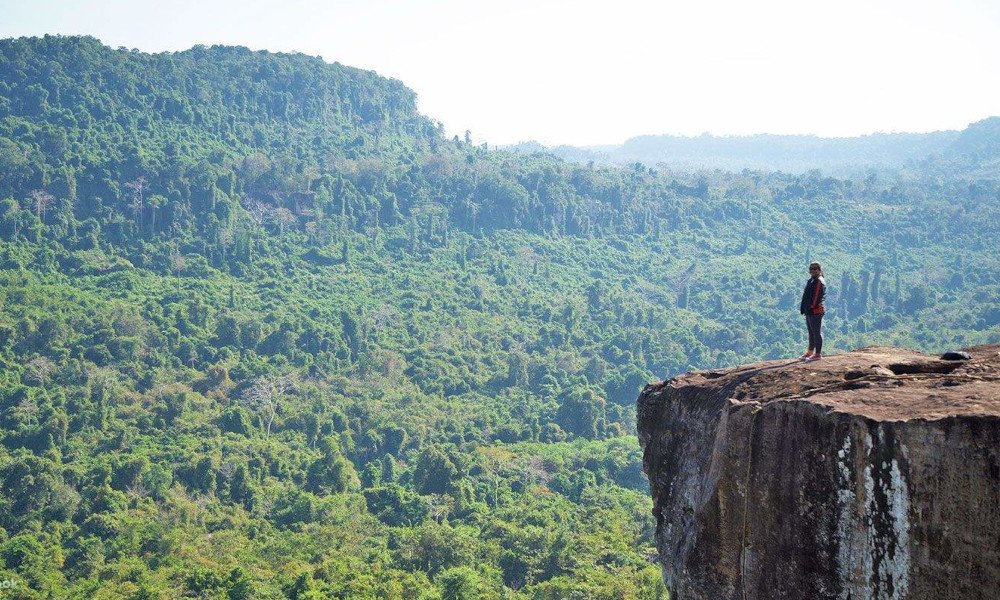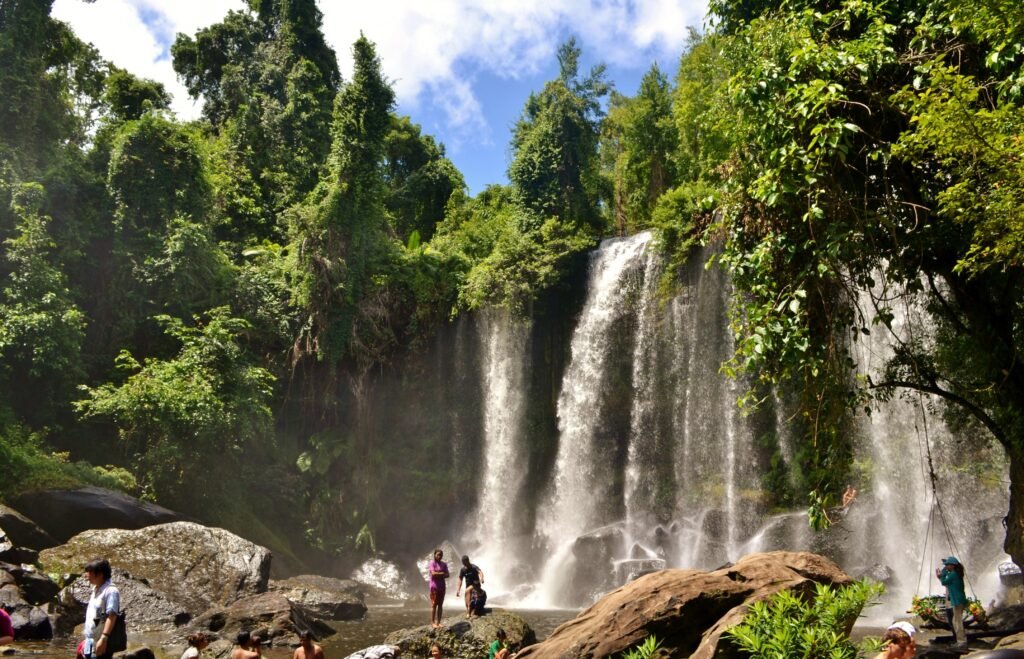Phnom Kulen National Park

Phnom Kulen mountain stands as one of Cambodia’s most esteemed attractions, situated approximately 1.5 to 2 hours from Siem Reap. The mountain derives its name from the numerous lychee trees that once flourished in the area. Today, it provides visitors with stunning vistas and a variety of recreational activities, including picnicking and swimming in waterfalls. Those intending to drive to the summit of Kulen Mountain should arrive early, as the access road operates on a one-way traffic system.
Approximately 50 kilometers from Siem Reap, Phnom Kulen is a site of great historical significance. Legend has it that King Jayavarman II proclaimed independence from Java here in 802 CE, marking the inception of the Khmer Empire as a sovereign nation.
Moreover, this site holds immense spiritual value, featuring several temples that are readily accessible. Among the most notable are the Thousand Lingas at Kbal Spean, located within Kulen National Park, and the Preah Ang Thom pagoda, which houses a colossal reclining Buddha. The area draws many “kru khmer” (natural medicine practitioners) and individuals seeking blessings from its sacred waters, particularly the revered life-giving waters at Kbal Spean, believed to assist couples in conception.
Experience an exclusive tour of Kulen Mountain, Beng Mealea, and Tonle Sap Lake, including transportation from Siem Reap. Discover the Reclining Buddha and the 1000...
Things to See and Do
- Thousand Lingas / Kbal Spean
Kbal Spean, situated along the ascent to the mountain’s summit, offers a tranquil and gentle environment. The site is renowned for its 1,000 intricately carved lingas, located in what is often called the “Valley of the Lingas” or “River of the Lingas,” serving as a homage to the Hindu deity Shiva. This location holds significant spiritual importance for the Cambodian populace, with local beliefs suggesting that the waters of Kbal Spean possess the ability to assist couples in conceiving.
In addition to the primary route leading up the mountain, visitors can also reach Kbal Spean by embarking on a 45-minute trek through the jungle from the Angkor Centre for the Conservation of Biodiversity (ACCB).
- Waterfall and Picnic Area
The upper section of the waterfall features a relatively flat area, making it suitable for families and young children wishing to enjoy the refreshing waters. Its proximity to a designated picnic area enhances its appeal as an ideal location for an afternoon of leisure, allowing visitors to alternate between relaxing and splashing in the water. Further downstream, a smaller waterfall provides a safe haven for timid swimmers and children.
To access the lower section of the waterfall, which is the main highlight, one must follow the stairs. During the wet season, the waterfall’s power is particularly impressive, with the sound of cascading water creating a captivating atmosphere. Despite its strength, many visitors are drawn to experience the waterfall up close. The water is generally not very deep, and in most areas of the basin beneath the waterfall, one can nearly reach the bottom. However, it is advisable to be a confident swimmer.
While many are aware of the connection between Ta Prohm temple and the film Lara Croft: Tomb Raider, fewer know that the Phnom Kulen waterfall makes a brief appearance in the movie. After evading living statues in the depths of Ta Prohm, Lara emerges at the top of the waterfall (despite the 42-kilometer distance!), where she leaps into the basin below. It is important to note that such a jump into relatively shallow water would likely be perilous, a fact that filmmakers often overlook in their portrayals.
- Preah Ang Thom
This site serves as the principal temple location at Kulen Mountain. It is essential to remove your shoes before entering the temple premises. Attendants are present at the designated area for shoe removal, and they will ensure the safekeeping of your footwear for a nominal fee. Upon entering, visitors can ascend towards the enormous reclining Buddha statue, which is claimed to be the largest in Cambodia; however, several seated Buddhas in the vicinity are even more imposing. Offering boxes are positioned along the length of the Buddha statue, adorned with numerous flowers and various tributes.
- Srah Damrei
Accessible solely by foot, Srah Damrei, known as Elephant Pond, features an array of stone-carved animals. This ancient Khmer artwork is complemented by a pair of lions and remnants of other creatures. The experience is highly rewarding and merits the effort of venturing off the usual path. Guides are often available in the Preah Ang Thom area; it is advisable to seek one to assist you in navigating this remarkable site.
How to Get There
Phnom Kulen is located 48 kilometers from Siem Reap, with a travel time of approximately 1.5 to 2 hours by car or van. The journey may take longer by tuk-tuk, particularly if one intends to walk both up and down the mountain (approximately 2 hours each way, offering breathtaking views), as tuk-tuks are unable to navigate the steep ascent.
The ticket office: is situated at the base of Phnom Kulen, serving as the entrance to Phnom Kulen National Park. Visitors must purchase their tickets here if they have not done so online and present their tickets for entry. Adequate restroom facilities are available at this location.
Following the ticket office, a further 20-minute drive along winding roads will lead you to the summit, where numerous markets offer souvenirs, clothing, snacks, and beverages. From this point, visitors can either ascend the grand staircase to the pagoda or take the lower path that leads to the waterfall and picnic areas.
Hiking: For those who enjoy hiking and are feeling adventurous, the trek from the base to the summit of Phnom Kulen is highly advisable.
To begin the hike up Kulen Mountain, take the main road to the right of the primary street leading to the entrance of Phnom Kulen National Park. After approximately 1 kilometer, you will encounter the entrance gate to Wat Prohm Bram Bey; proceed through this gate and ascend the stairs at the front. At Wat Prohm Bram Bey, various paths are available, all of which will eventually converge. Upon reaching Wat Preah Cup, take the stairs on the right side of the pagoda to discover a natural spring, swimming pool, and spirit house. After your exploration, ascend the stairs on the left side of the pagoda to access a dirt path through the jungle. Follow this path for about an hour until you arrive at a small village, continuing onward until you reach the bridge near Kbal Spean. Be prepared to present your entrance ticket at this juncture. From there, it is a straightforward walk to Wat Preah Ang Thom, Kbal Spean, or the Phnom Kulen waterfalls.
A private taxi or car rental: for a full day typically costs around $50, while vans range from $60 to $80. Additionally, organized tours that include a knowledgeable English-speaking guide are also offered. It is advisable to make reservations in advance, as this will help you save time during your stay in Siem Reap.
On your return journey, you may also consider visiting the Banteay Srei area. However, if you intend to explore the temples of Banteay Srei and Banteay Samre, an Angkor pass will be required.
Another excellent option to conclude your day is a trip to Beng Mealea, located just 7 kilometers from Phnom Kulen. This temple, surrounded by a 1.2-kilometer-wide moat, is a stunning site to explore, still enveloped in jungle overgrowth and largely untouched.
History
In ancient Khmer, Phnom Kulen was referred to as Mahendraparvata, meaning “Mountain of Indra, the King of the Gods.” This location was a bustling city comparable in size to contemporary Phnom Penh and served as the birthplace of the Khmer Empire, where King Jayavarman II declared Cambodia’s independence from Java in AD 802. Subsequently, the capital was relocated to Roluos Group, previously known as Hariharalaya.
Although familiar to local inhabitants, the ancient city of Kulen was officially rediscovered by explorers in 2012. Initially, through a ground expedition and later utilizing LIDAR technology, researchers Jean-Baptiste Chevance and Damian Evans revealed Mahendraparvata along with several significant temples, including Prasat O’Paong, which features a pyramid-like structure with three tiers and five towers, reminiscent of those found at Angkor Wat.

